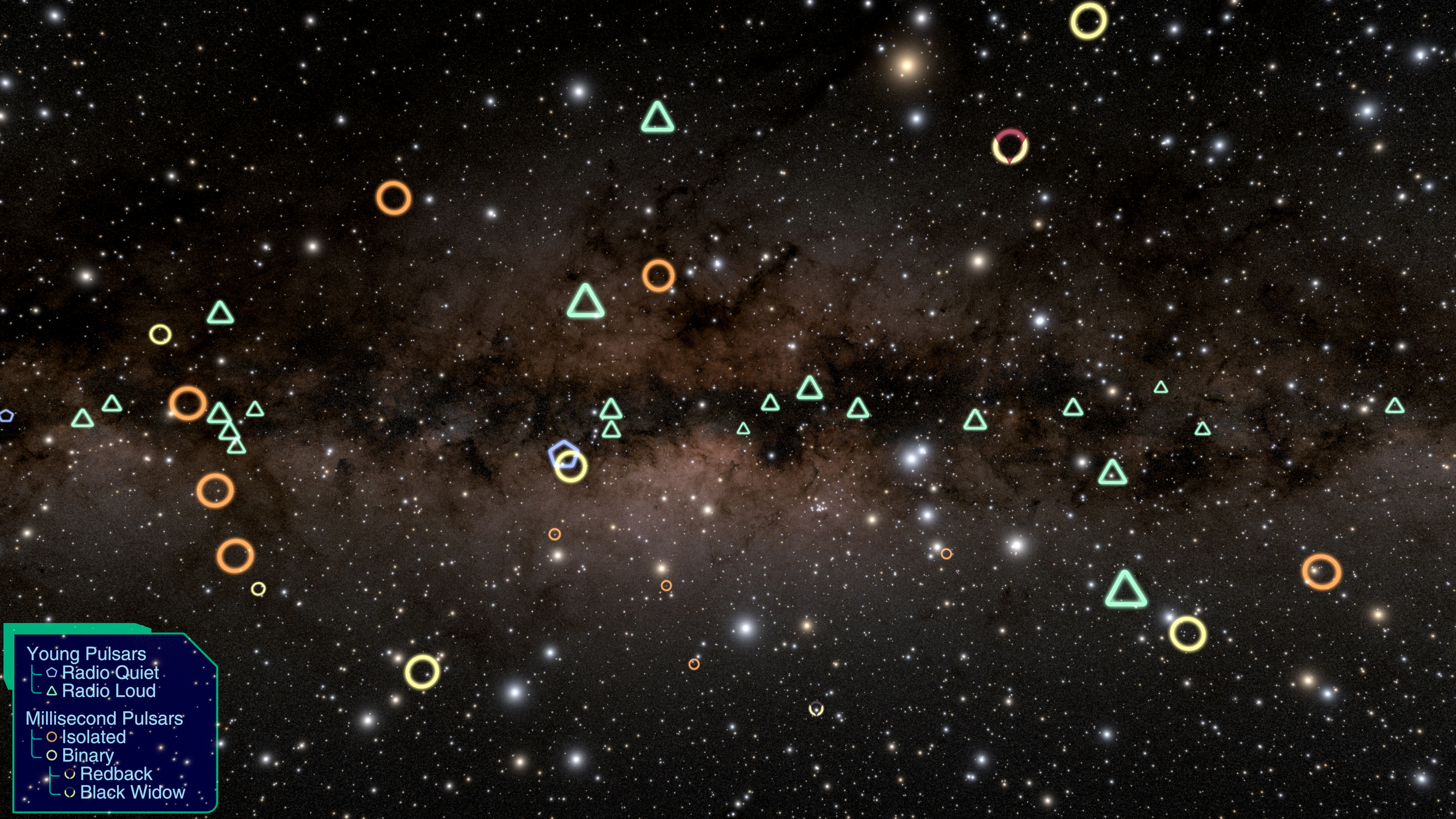NASA’s Fermi Finds Vast ‘Halo’ Around Nearby Pulsar
Astronomers using data from NASA’s Fermi mission have discovered a pulsar with a faint gamma-ray glow that spans a huge part of the sky. Watch to learn more.
Credit: NASA’s Goddard Space Flight Center
Music: "Insight" from Universal Production Music
Watch this video on the NASA Goddard YouTube channel.
Complete transcript available.
A new study of observations from NASA’s Fermi Gamma-ray Space Telescope has discovered a faint but sprawling glow around a nearby pulsar. If visible to the human eye, this gamma-ray “halo” would appear larger in the sky than the famed Big Dipper star pattern. This structure may provide the solution to a long-standing mystery about the amount of antimatter in our neighborhood.
Astronomers have been vexed by a decade-long puzzle about one type of cosmic particle arriving from beyond the solar system. Positrons, the antimatter version of electrons, turn out to unusually abundant near Earth.
A neutron star is the crushed core left behind when a star much more massive than the Sun runs out of fuel, collapses under its own weight and explodes as a supernova. We see some neutron stars as pulsars, rapidly spinning objects emitting beams of radio waves, light, X-rays and gamma rays that, much like a lighthouse, regularly sweep across our line of sight.
Geminga (pronounced geh-MING-ga) is among the brightest pulsars at gamma-ray energies.
To study its halo, scientists had to subtract out all other sources of gamma rays, including diffuse light produced by cosmic ray collisions with interstellar gas clouds. Ten different models of interstellar emission were evaluated.
What remained when these sources were removed was a vast, oblong glow spanning some 20 degrees — about 40 times the apparent size of a full Moon — at an energy of 10 billion electron volts (GeV), and even larger at lower energies.
The team determined that Geminga alone could be responsible for as much as 20% of the high-energy positrons seen by other space experiments. Extrapolating this to the cumulative emission of positrons from all pulsars in our galaxy, the scientists say it’s clear that pulsars remain the best explanation for the observed excess of positrons.
Same as above, but without on-screen text blocks.

This model of Geminga's gamma-ray halo shows how the emission changes at different energies, a result of two effects. The first is the pulsar's rapid motion through space over the decade Fermi's Large Area Telescope has observed it. Second, lower-energy particles travel much farther from the pulsar before they interact with starlight and boost it to gamma-ray energies. This is why the gamma-ray emission covers a larger area at lower energies. One GeV represents 1 billion electron volts — billions of times the energy of visible light.
Credit: NASA’s Goddard Space Flight Center/M. Di Mauro
GIF version

Unlabeled version of the above.
Credit: NASA’s Goddard Space Flight Center/M. Di Mauro
GIF version
Halo model with labels, video version.
Credit: NASA’s Goddard Space Flight Center/M. Di Mauro
Unlabeled version of the above.
Credit: NASA’s Goddard Space Flight Center/M. Di Mauro
Video version

This animation shows a region of the sky centered on the pulsar Geminga. The first image shows the total number of gamma rays detected by Fermi’s Large Area Telescope at energies from 8 to 1,000 billion electron volts (GeV) — billions of times the energy of visible light — over the past decade. By removing all bright sources, astronomers discovered the pulsar’s faint, extended gamma-ray halo.
Credit: NASA/DOE/Fermi LAT Collaboration

Unlabeled version of the above.
Credit: NASA/DOE/Fermi LAT Collaboration
This video opens on a region of the sky centered on the pulsar Geminga. The image shows the total number of gamma rays detected by Fermi’s Large Area Telescope at energies from 8 to 1,000 billion electron volts (GeV) — billions of times the energy of visible light — over the past decade. By removing all bright sources, astronomers discovered the pulsar’s faint, extended gamma-ray halo.
Credit: NASA/DOE/Fermi LAT Collaboration
Unlabeled version of the above.
Credit: NASA/DOE/Fermi LAT Collaboration

Starlight interacting with particles travelling close the speed of light can be boosted to gamma-ray energies. This animation shows the process, known as inverse Compton scattering. Light ranging from microwave to ultraviolet wavelengths collides with a fast-moving particle and transforms into a gamma ray, the highest-energy form of light.
Credit: NASA’s Goddard Space Flight Center

These images show a region of the sky centered on the pulsar Geminga. Left: The total number of gamma rays detected by Fermi’s Large Area Telescope at energies from 8 to 1,000 billion electron volts (GeV) — billions of times the energy of visible light — over the past decade. Brighter colors correspond to greater numbers of gamma rays. Right: By removing all bright sources, astronomers discovered the pulsar’s faint, extended gamma-ray halo.
Credit: NASA/DOE/Fermi LAT Collaboration

Unlabeled version of the above.
Credit: NASA/DOE/Fermi LAT Collaboration
For More Information
Credits
Please give credit for this item to:
NASA's Goddard Space Flight Center. However, individual items should be credited as indicated above.
-
Science writer
- Francis Reddy (University of Maryland College Park)
-
Producer
- Scott Wiessinger (USRA)
-
Scientist
- Mattia Di Mauro (Catholic University of America)
Release date
This page was originally published on Thursday, December 19, 2019.
This page was last updated on Wednesday, May 3, 2023 at 1:45 PM EDT.
Missions
This visualization is related to the following missions:Series
This visualization can be found in the following series:Datasets used in this visualization
-
[Fermi]
ID: 687
Note: While we identify the data sets used in these visualizations, we do not store any further details, nor the data sets themselves on our site.
